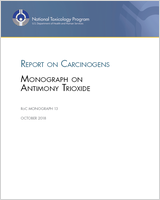This is a work of the US government and distributed under the terms of the Public Domain
NCBI Bookshelf. A service of the National Library of Medicine, National Institutes of Health.
National Toxicology Program. Report on Carcinogens Monograph on Antimony Trioxide: RoC Monograph 13 [Internet]. Research Triangle Park (NC): National Toxicology Program; 2018 Oct.

Report on Carcinogens Monograph on Antimony Trioxide: RoC Monograph 13 [Internet].
Show detailsAntimony is a metalloid found in nature in over 100 mineral species; it can exist in four oxidation states, −3, 0, +3, and +5, of which the Sb(III) (trivalent) and Sb(V) (pentavalent) forms are the most common in nature. Elemental antimony is a silver-white metal used primarily to make alloys. The trivalent compound antimony(III) trioxide is the most commercially significant form of processed antimony, used primarily as a synergist for halogenated flame retardants in plastics, rubber, and textiles.
The objective of this monograph is to conduct a cancer hazard evaluation of antimony(III) trioxide for possible listing in the Report on Carcinogens (RoC). Antimony species can be interconverted in the environment and in vivo. The monograph evaluation focuses on antimony(III) trioxide and also provides scientific and exposure information on elemental antimony and other antimony compounds, because (1) people can be exposed to antimony(III) trioxide resulting from transformation from other forms of antimony, and (2) studies of biological effects and other relevant information may inform understanding of antimony(III) trioxide’s mechanistic basis for potential carcinogenicity. Table 1 summarizes the evidence streams, exposures of interest, and outcomes. This is somewhat analogous to a “population, exposure, comparator, outcome” statement (Whaley et al. 2016) except that population has been replaced by evidence stream (e.g., humans, experimental animals, in vitro studies). The comparator (no or low exposure to antimony compounds) is the same for all outcomes.
Table 1
Summary of Evidence Streams, Exposures of Interest, and Outcomes.
The monograph also assesses exposure information (summarized in Table 2) to determine whether a significant number of people residing in the United States are currently exposed or were exposed in the past to antimony(III) trioxide.
Table 2
Summary of Exposure Information.
- Introduction - Report on Carcinogens Monograph on Antimony TrioxideIntroduction - Report on Carcinogens Monograph on Antimony Trioxide
- MIGS Cultured Bacterial/Archaeal sample from Companilactobacillus mishanensisMIGS Cultured Bacterial/Archaeal sample from Companilactobacillus mishanensisbiosample
- Homo sapiens profilin 1, mRNA (cDNA clone MGC:2264 IMAGE:3349355), complete cdsHomo sapiens profilin 1, mRNA (cDNA clone MGC:2264 IMAGE:3349355), complete cdsgi|33990783|gb|BC002475.2|Nucleotide
Your browsing activity is empty.
Activity recording is turned off.
See more...